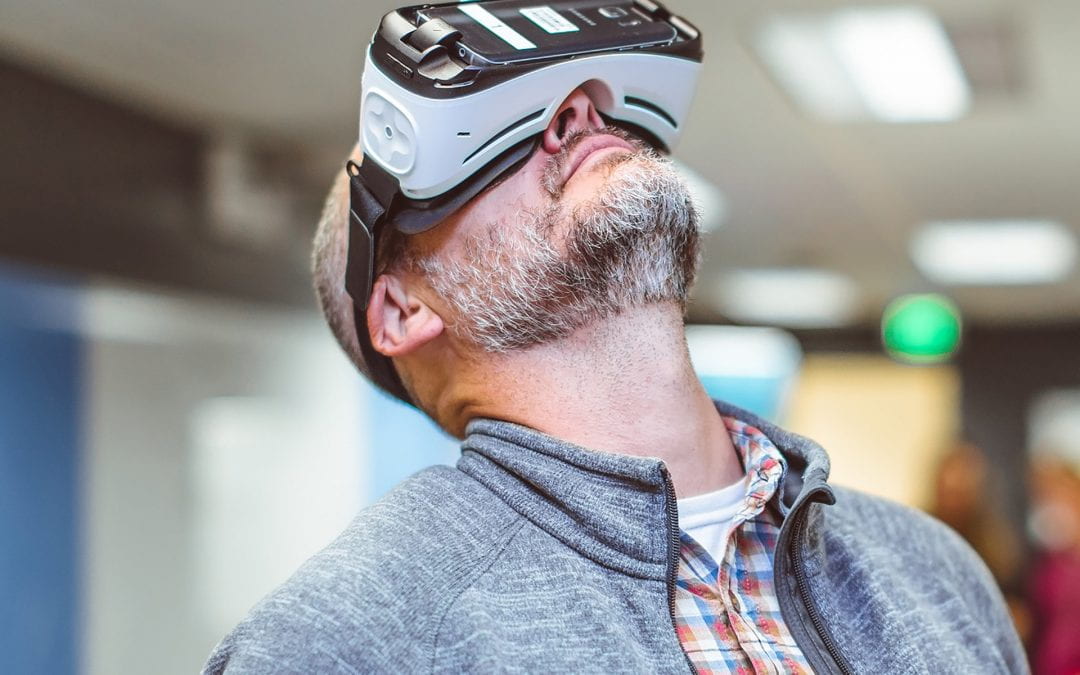
Apr 14, 2021 | Home Page
Penn State’s Teaching and Learning with Technology (TLT) is accepting applications for the 2021-22 academic year’s Faculty Engagement Awards. The theme for this year’s projects is interactive 360-degree video.
“We’re eager to work with faculty on investigating the benefits and best practices of creating and integrating interactive 360-degree video into coursework,” said Bart Pursel, director of innovation with TLT. “Also, immersive technology like this exemplifies the ‘Transforming Education’ and ‘Empowering Through Digital Innovation’ pillars of Penn State’s Strategic Plan.”
TLT’s Faculty Engagement Awards are allocated annually around a specific theme that combines sound pedagogy and digital tools. This year’s focus, interactive 360-degree video, intends to leverage technology that can immerse students in experiences they otherwise wouldn’t be able to access.
Penn State faculty with ideas for exploring interactive 360-degree video’s educational potential are encouraged to apply for this year’s Faculty Engagement Awards. The window for applications is open from Wednesday, April 14 to Friday, April 30, 2021. Award winners will be contacted in May.
Faculty Engagement Award recipients will collaborate with an instructional designer and technology support staff to identify effective in-class uses of interactive 360-degree video. Additionally, TLT researchers will help to assess the technology’s impact and share relevant findings with the Penn State community.
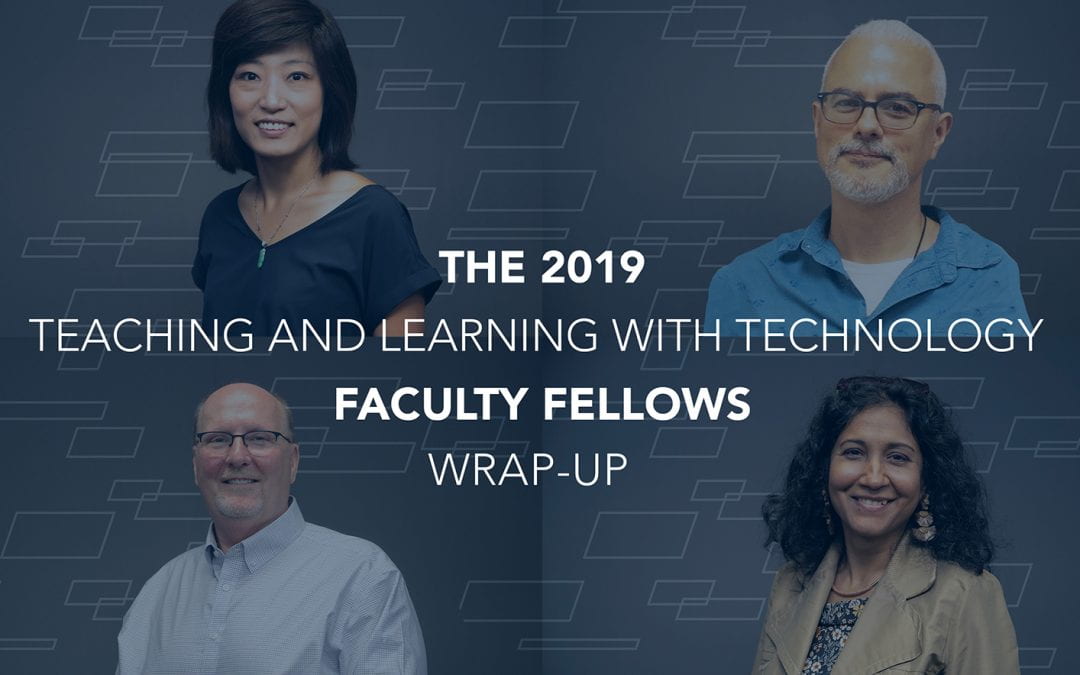
Aug 11, 2020 | Home Page
Last academic year, four Penn State instructors worked with teams from Teaching and Learning with Technology (TLT) to enhance the spaces where students learn. With preparations underway for the new academic year, the most recent cohort of TLT Faculty Fellows; Ed Glantz, Siu Ling (Pansy) Leung, Pierce Salguero, and Priya Sharma can share lessons learned from their work.
Ed Glantz – Personalizing Learning Spaces by Streaming and Recording Lectures
Glantz, a teaching professor and assistant director of masters programs in the College of Information Sciences and Technology (IST), utilized his fellowship to explore best practices in recording classroom lectures and how those recordings can help with reflective teaching. Penn State’s resources, particularly Zoom, Kaltura, and Canvas, allowed Glantz and his team to dive deeper into technical requirements and the pedagogical value of recording classroom lectures. Many of their findings helped develop content that is available now.
The group compiled three semesters’ worth of recorded course content in face-to-face “residential” and remote synchronous instructional settings. They then found that live session streaming and supplemental recording is feasible in college and general-purpose classroom sections of up to 150 students. Additionally, they noted that recorded lectures could supplement student engagement in the event of excused absences.
Glantz’s project’s implications are being felt in real-time as Penn State faculty and students deal with hybrid learning spaces this fall. One of the most noteworthy findings from the project is the importance of accounting for things like time zone differences and students’ technical obstacles (like high-quality wireless access) and their impact on hybrid or remote learning environments. That information has helped inform training that is now available to Penn State faculty.
Siu Ling (Pansy) Leung – Using Mixed Reality to Prepare Students for Better Laboratory Learning Experiences
Leung, an assistant teaching professor and director of undergraduate laboratories in the department of Mechanical Engineering, explored how to improve students’ learning experiences with virtual labs instead of traditional ones. With assistance from TLT staff, she transformed a machine-based mechanical engineering experiment into two virtual platforms; a desktop version for broad student access, including remote learning, and a virtual reality version for immersive learning.
The virtual experiment included features like student progress tracking through user log-in and data capture, a real-time graphing system for capturing, displaying, and playback of virtual object movement, a linear story around the experiment to help with motivation, and a functioning virtual scientific calculator.
While the focus of Leung’s project in the last year was on development, the plan going forward is to implement the virtual experiment in the classroom. Its deployment will support the ongoing need for remote learning and provide opportunities to study how immersive coursework impacts student engagement.
Pierce Salguero – Expanding the Asian Studies Classroom Through Virtual Learning Spaces
Salguero, associate professor of Asian history and religious studies at Penn State Abington, used immersive technology to build upon an ongoing pedagogical project that educates students on Japanese Buddhist temples without the expense of travel. He and his team also worked toward improving students’ digital fluency by having them produce immersive content.
Through technical and pedagogical training in filmmaking, editing, and publication of 360-degree video, students and faculty were able to perform immersive, ethnographic fieldwork in Philadelphia-area temples. The training and fieldwork provided the foundation upon which Salguero’s team developed pedagogical supports, including lesson plans, to assist faculty in any discipline in their efforts to incorporate multimedia in their coursework.
The coronavirus pandemic paused Salguero’s planned travel to Japan to collect immersive content as the foundation of virtual field trips to Japanese temples. He hopes to resume that work when conditions permit.
Priya Sharma – Reconceptualizing Places of Learning
Sharma, an associate professor in the College of education, and her team dove deep into literature and empirical research to search for evidence on how to create learning places instead of learning spaces. The theory that launched her project was that learning spaces are arrangements of objects, tools, learners, and instructors within a geometrical area while a learning place centers around a lived, personalized experience.
After reading approximately 50 published works on learning places and spaces, Sharma’s group found that the concepts are typically treated interchangeably. It also became apparent that the discussion of learning places and spaces rarely includes an online learning component. They were able to identify some distinguishable characteristics between “place” and “space” that could help inform how learning spaces are designed to create a sense of belonging and community that makes it a learning place.
Sharma plans to continue her work by researching courses that take place in experimental classrooms at University Park, and by examining online communities for elements of “place.”
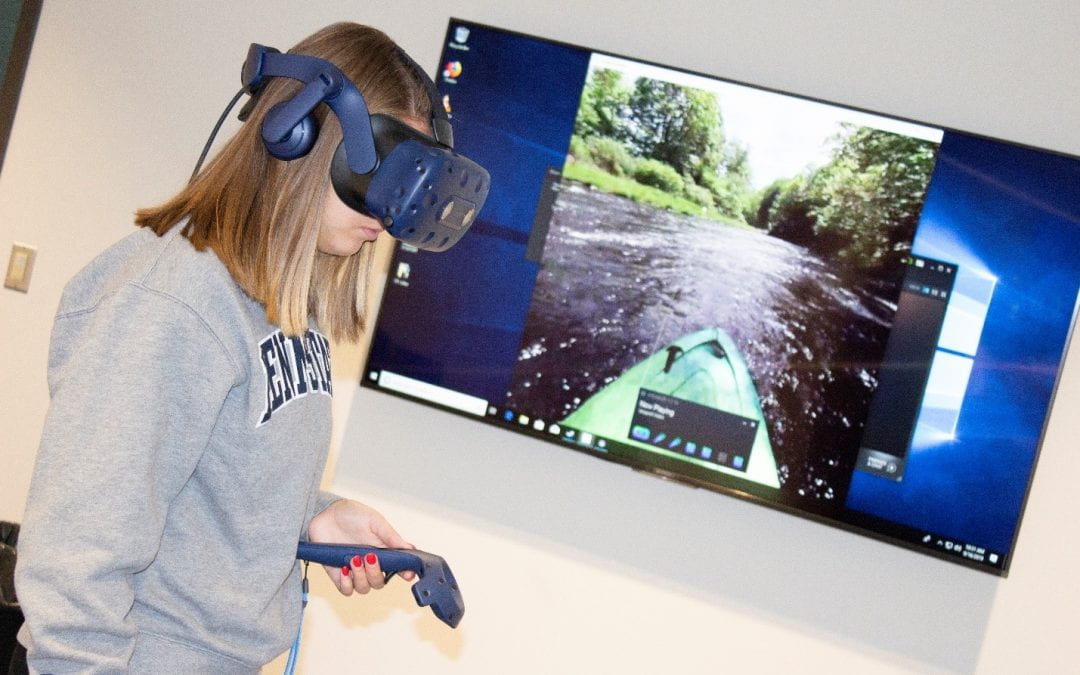
Jul 10, 2020 | Home Page
What if you could skip the field trip and virtually transport yourself to any environment? For many, this may be more of a necessary reality amid the COVID-19 pandemic, and Theresa Black, a science lecturer at Penn State Scranton, is ahead of the curve.
“With 360-degree video, you learn different ways to engage your students,” Black said. “Over the last year, I have learned a lot about the various technologies we can use, which has been especially helpful with the campus shut down. I feel comfortable enough to be able to use it again if we end up having a similar situation in the fall.”
In recent years, immersive technology has been an excellent teaching tool for faculty, who can receive support through Media Commons, a Penn State Teaching and Learning with Technology service. Media Commons helps faculty incorporate 360-degree video into their courses in ways that seamlessly integrate into their current curriculum.
“The addition of 360-degree video into a class can be transformative,” said Media Commons campus consultant Carla Seward. “It allows faculty to facilitate experiences to which their students may not otherwise have access. The technology can help students see different parts of the world and explore various climates and cultures; there are almost no limits.”
During spring 2019, inspired by the Biome in a Box project at Penn State Lehigh Valley, Black reached out to Media Commons to discuss how she could incorporate 360-degree video into her Earth 111 Water: Science & Society course. Seward helped her obtain a 360-degree camera, which Black used both with a tripod and mounted to her kayak, to capture a wetland and a variety of locations along the Lehigh River in Eastern Pennsylvania. Using Adobe Premiere Pro, Black edited her videos into a 10-minute tour of the Lehigh River and a 2.5-minute tour of a wetland.
To view these videos, Black’s 30 students worked in pairs and booked 30-minute appointments at the Scranton campus’s Immersive Lab. Working in pairs assists students who are visually impaired, Black explained, and the availability of a video transcript helps students who are auditory impaired. Students completed short-answer questions after using virtual reality headsets to immerse themselves in the wetland and the Lehigh River. The videos supplemented their lessons about the differences between flowing water and standing water ecosystems, in addition to the variances that occur as a stream moves from its headwaters to its mouth.
Even though the course focuses on earth science, it has a social science component, focusing on the human use of water. Overlaying the video clips, Black voiced tidbits about the history of the Lehigh River, which further enhanced students’ learning.
Black’s students were extremely engaged in the project. For many, it was a fascinating experience, since it was the first time they have used a virtual reality headset. They appreciated how the Immersive Lab allowed them to have real-life opportunities only previously afforded by field trips.
“Having a live view that you can move through and manipulate adds to the learning experience,” said Scranton senior Maggie Podunajec. “Apart from this course, using this technology provides students with experiences and knowledge that they may not otherwise have access to.”
Black plans to continue using these videos in the fall and hopes to capture more environments of which would be difficult to take 30 students to and that they otherwise have never seen in person.
“One thing I would like to do in the future—I’m not sure if it will work out this year with travel restrictions—is create a comparative watershed video in the southwest,” Black said. “We talk a lot in this class about the differences in areas like ours where we have tons of water, and there is a lot of overland flow, compared to places out west, where there’s very little. I would love to do a different experience where they can compare the two and visually experience them.”
Penn State faculty interested in incorporating 360-degree video and other immersive technologies in their courses can contact Media Commons. For resources and examples of 360-degree videos made by Penn State faculty, faculty can visit the Immersive Experiences Lab’s Experience Catalog.
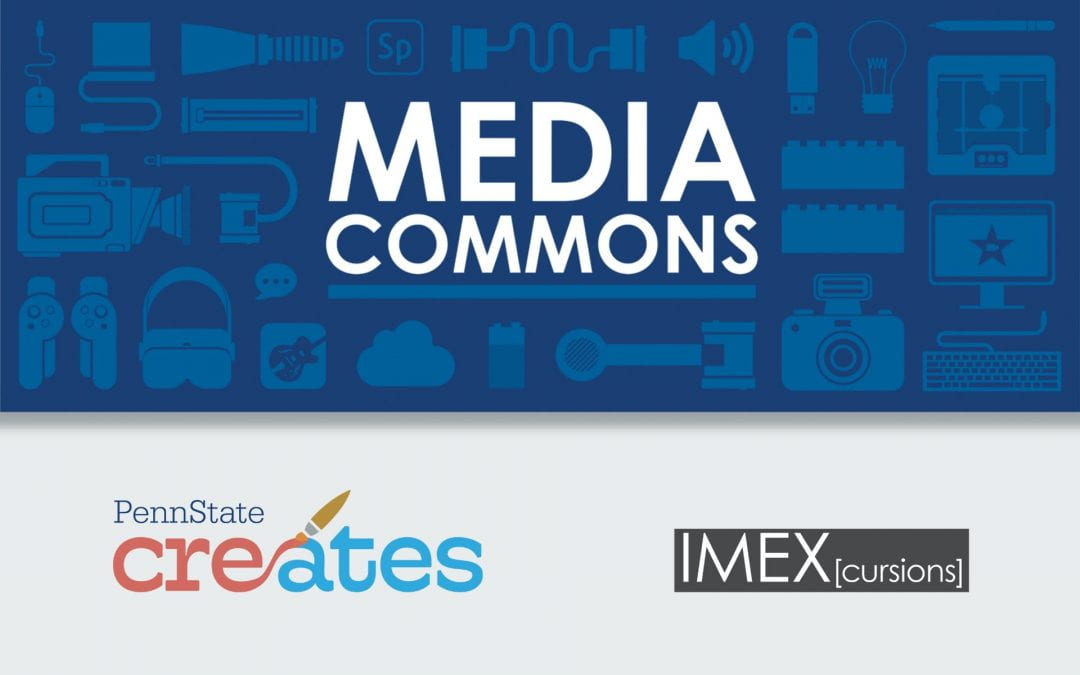
Apr 9, 2020 | Home Page
Media Commons, presented by Penn State’s Teaching and Learning with Technology (TLT), has unveiled two new initiatives designed to help the University community get creative and also explore while sheltering at home.
“While Penn Staters are practicing social distancing to stay safe and healthy, we realize that there is a need to spend time in enriching activities,” said Bart Pursel, interim director of innovation with TLT. “We’re excited about offering programs to the entire Penn State community that allow participants to learn something new and exercise their creativity in an informal environment.”
Penn State Creates debuts on Wednesday, April 15, at 3:00 p.m. with an Adobe Fresco Painting Party. This is the first in a weekly series of sessions that gives attendees the chance to explore new forms of expression through technology. The relaxed, informal programs require no previous experience with the software or technology.
At the inaugural Penn State Creates painting party, participants will use Adobe Fresco to create digital works of art. An iPad, or another compatible tablet, is needed to participate along with the free Adobe Creative Cloud account available to University students, faculty, and staff. The painting party will be hosted via Zoom, and anyone who does not have an Adobe Fresco-compatible tablet is welcome to join and watch as the art is created in real-time.
More information on upcoming Penn State Creates sessions can be found by bookmarking the webpage or by following TLT and Media Commons on Twitter. University students, faculty, staff, alumni, and the Penn State community throughout the Commonwealth are all invited to take part.
For those who want to explore far-off locales with the help of immersive technology, there is the IMEX[scursions] program. Immersive technology can include 360-degree video, virtual reality, and augmented reality; its use can allow for up-close, hands-on discovery of cultures’ landmarks, traditions, cuisines, and more.
The team at Penn State Media Commons’ Immersive Experience Lab (IMEX Lab) plans to add a new, worldly excursion to the catalog each week. Currently, it offers explorations of France, South Korea, and Egypt. Those who are interested in taking an IMEX[cursion] should review the equipment requirements to be fully prepared for their trip.
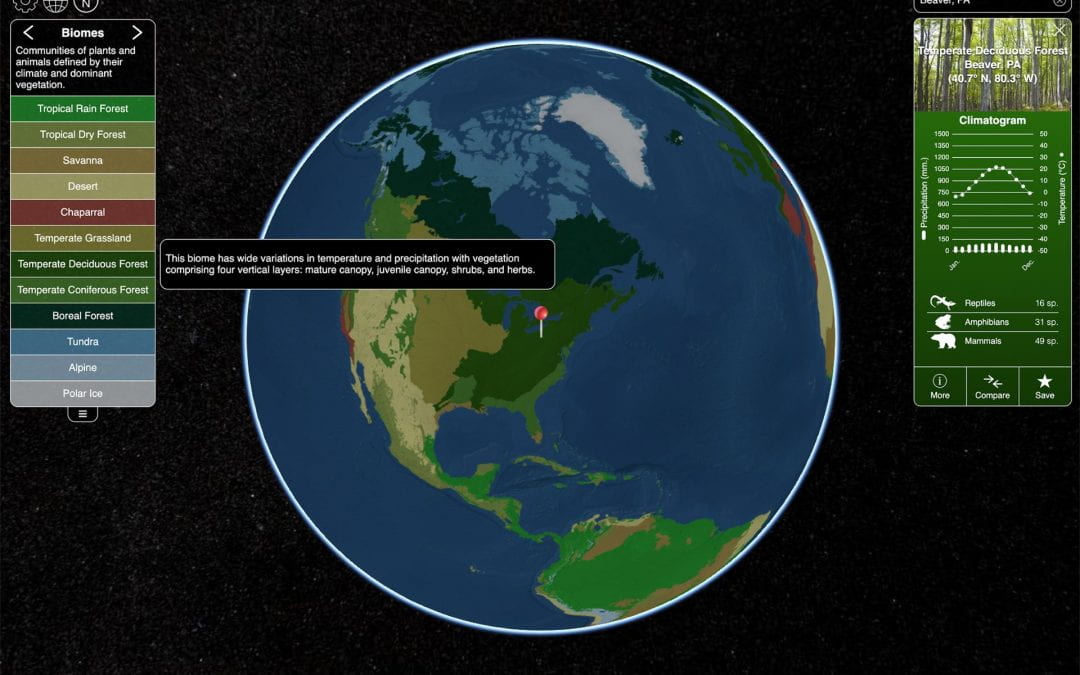
Feb 21, 2020 | Home Page
As video technology becomes more prevalent as a method of conveying information to learners of all ages, faculty are integrating videos into their courses in an interactive way to engage students. Beyond just watching videos in a lecture, faculty are also incorporating virtual reality (VR) immersive experiences into the classroom that allow for active learning, drawing students’ attention to the critical points being taught in the course.
Working with faculty, staff, and students across Penn State, Media Commons is a University-wide initiative aimed to provide support and resources to incorporate digital media projects into the classroom. Media Commons is a Penn State Teaching and Learning with Technology (TLT) service that creates and maintains innovative learning facilities, as well as empowering students to become media-creators.
Students across Penn State’s campuses – from Penn State Beaver to New Kensington, and Shenango – are trailblazing the future of education with immersive technology in and outside of the classroom.
“Media Commons has always focused on the intersection of multimedia-based creativity and the classroom,” said Nick Smerker of Media Commons. “By leveraging our years of experience supporting students and faculty in their sharing of compelling stories, we aim to bring this focus on storytelling into a whole new realm of expressive tech.”
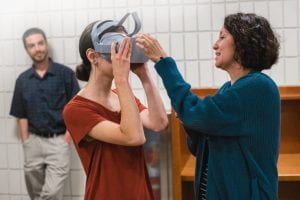
During a Media Commons showcase centered around a newly installed immersive experiences (IMEX) viewing pod, Penn State New Kensington students and faculty consulted with Media Commons staff to explore 360-degree cameras and virtual reality headsets. Yesenia Figueroa-Lifschitz, library assistant (right), helps sophomore Olivia Ahr try on a headset.
Last spring, an immersive experience (IMEX) viewing pod was installed at Penn State New Kensington. The new space is equipped with the same furniture used in the IMEX Lab at University Park. The ergonomic chairs are specifically designed to support a 360-degree range of body movement, allowing visitors to fully engage in a virtual reality environment.
Penn State New Kensington’s viewing pod has been used in a variety of ways, from an immersive art exhibit to the virtual exploration of South Korea, the 2019-20 pick for the campus’ Country of Focus study program. The viewing pod is open Monday-Thursday 8 a.m.- 8 p.m., Friday 8 a.m.- 5 p.m. for students to explore immersive technologies. To learn more or to reserve the pod, visit the Penn State New Kensington location page.
At Penn State Beaver, students in BIOL 220W (GN) Populations and Communities are connecting their learning material to the real world through 360-degree videos and interactive in-class activities. Cassandra Miller-Butterworth, associate professor of biology at the Beaver campus, has been teaching Populations and Communities for many years. Until this past spring, she would spend the first two weeks of class reviewing different biomes through a series of photos. “Most of my students were not engaged during this section of the course because I would describe a biome, and then show a photo of it. My goal was to try to make it more interesting and interactive to help students retain that information better,” says Miller-Butterworth.
With the help of Smerker, Miller-Butterworth was able to give her students an interactive in-class activity that depicts the twelve terrestrial and six marine biomes. Navigating through an interactive BiomeViewer map, students discovered different biomes with descriptions of its distinguishing features as well as search specific locations on the globe to explore additional information on climate, plant life, and animal species.
Smerker also helped Miller-Butterworth find and upload 360-degree immersive videos of the biomes to the Penn State IMEX Lab’s Experience Catalogue, an evolving list of 360-degree videos and virtual reality apps of varied disciplines, curated by the Media Commons team to engage students through the use of immersive content.
Miller-Butterworth’s students were able to launch a 360-degree video of a biome directly on their phones by clicking on a link to the content in the Experience Catalogue, which corresponded to the respective biome on the interactive map. Students then inserted their phones into a VR headset, allowing them to immerse themselves in the selected biome.
Sophomore Heaven Bowman enjoyed the immersive videos, which expanded her enthusiasm in the subject. “I loved how the technology enabled me to have such a hands-on experience in the classroom. I completely felt like I was in the rainforest and the desert, so it allowed me to understand more of the ecological aspects of the biome. It was engaging and made me want to experience more.”
Miller-Butterworth says anything that brings abstract concepts to life for students is essential. She points to this generation’s affinity for technology and watching videos, especially on their phones. “If you can bring those [technology] skills they already have and things they enjoy doing into the classroom, that helps them stay engaged and retain more information than a traditional lecture.”
The use of 360-degree videos of biomes in the classroom was first explored by 2018 TLT Faculty Fellow and associate teaching professor of biology, Karen Kackley-Dutt, to provide students the opportunity to observe Earth’s biomes for themselves through an immersive experience.
At Penn State Shenango, assistant teaching professor of nursing Maureen Dunn has also been very successful in implementing immersive reality approaches from her time in the 2018-19 Blended Learning Transformation (BlendLT) cohort, a program supported by TLT.
Dunn’s NURS 417 Family and Community Health Concepts, taught in spring 2019, was transformed from a fully face-to-face course to a blended environment. Teaching with immersive reality is appealing to Dunn because her students are adult learners. Most have full-time nursing jobs, often with long shifts, and families, which make it difficult to attend class. Her students appreciate the flexibility to complete assignments at home or at a time that fits with their schedule.
One assignment that posed a challenge for nursing students was a windshield survey. During the windshield survey, students were asked to go into the community to identify both the benefits and challenges in health education and local services.
Working alongside TLT staff, Dunn recorded eight different 360-degree videos that her students could view anywhere on their phones to complete the windshield survey. Students watched these videos, used Adobe Premiere to make edits, and through VR headsets, they learned more about what community health resources were available for individuals.
Smerker is enthusiastic about the 360-degree videos and their use in this type of course going forward. “Students benefit from being able to make informed decisions about how they tell the stories that matter to them. Whether as producers or consumers of immersive content, this fluency in technology-aided storytelling will be invaluable in sharing information in the years ahead.”
Instructors interested in starting to explore immersive reality in the classroom can explore the IMEX Lab’s Experience Catalogue’s digital resources. Media Commons also provides interactive workshops to teach students how to use iMovie and 360-degree video equipment to create immersive reality videos.





